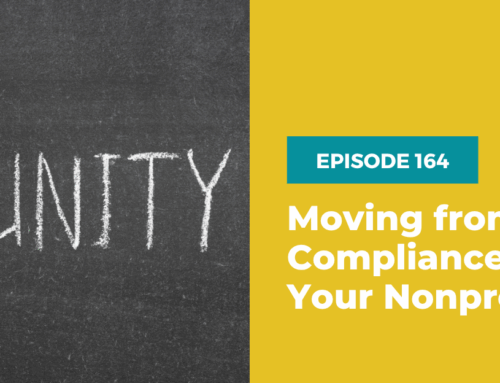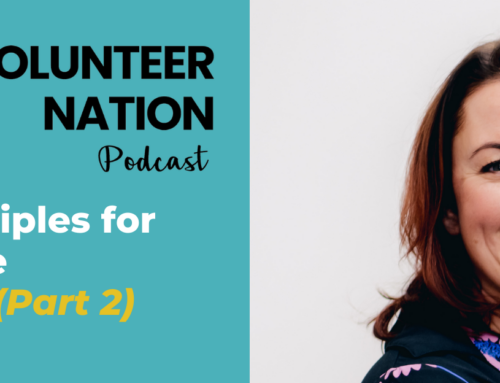
January 23, 2025
Episode #146: Expanding Volunteer Jobs to Be Done at Your Nonprofit
In this episode of the Volunteer Nation Podcast, Tobi dives into the art of expanding volunteer roles within nonprofits. Inspired by a recent workshop, she breaks down the essential steps to designing an effective volunteer program that truly meets organizational needs.
From setting clear volunteer goals to brainstorming new roles, aligning with volunteer interests, and collaborating with colleagues, Tobi shares a practical, step-by-step approach to unlocking the full potential of volunteer talent.
Volunteer Jobs – Episode Highlights
- [00:30] – Expanding Volunteer Jobs at Your Nonprofit
- [02:13] – Building a Volunteer Operations Plan
- [05:07] – Determining Volunteer Needs and Roles
- [09:13] – Brainstorming Volunteer Opportunities
- [12:39] – Engaging Volunteers in Various Tasks
- [17:29] – Leading the Way in Volunteer Services
- [20:45] – Collaborating with Coworkers to Expand Roles
- [23:12] – Timing and Strategic Planning for Volunteer Roles
Volunteer Jobs – Quotes from the Episode
“ We often think about our own organization’s needs, but we’ve got to meet the needs of today’s volunteers. Otherwise, they’re simply not going to contribute their time and talent to us. The more variety you can offer, the more you can appeal to a wider audience.”
Helpful Links
About the Show
Nonprofit leadership author, trainer, consultant, and volunteer management expert Tobi Johnson shares weekly tips to help charities build, grow, and scale exceptional volunteer teams. Discover how your nonprofit can effectively coordinate volunteers who are reliable, equipped, and ready to help you bring about BIG change for the better.
If you’re ready to ditch the stress and harness the power of people to fuel your good work, you’re in exactly the right place!

Contact Us
Have questions or suggestions for the show? Email us at wecare@volpro.net.
Rate, Review, & Follow Us on Apple Podcasts
If you love the content Tobi shares on the Volunteer Nation podcast, consider rating and reviewing the show! This helps us reach more people – and help more good causes just like yours – successfully engage enthusiastic, dedicated volunteers with less stress and more joy.
Click here, scroll to the bottom, tap to rate with five stars. Then, select “Write a Review” and let us know what you loved most about this episode!
Also, if you haven’t done so already, follow the podcast so you don’t miss a thing. Follow now!
Subscribe to ProNews: Our Weekly Resource Roundup
If you’d like to stay up to date on all new podcasts, blogs, freebies, and deals posted on our Tobi Johnson & Associates and VolunteerPro websites, subscribe to our weekly ProNews newsletter.
Every Wednesday, we’ll send you a digest of our freshest content, plus a bonus! Once you confirm your subscription, you’ll get our [Free eBook] The New Volunteer Manager: The First 90 Days.
Episode #146 Transcript: Expanding Volunteer Jobs to Be Done at Your Nonprofit
Tobi: Well, Hey everybody. Welcome to another episode of the volunteer nation podcast. I’m your host, Tobi Johnson. And today I want to talk about expanding volunteer jobs to be done at your nonprofit. This is so top of mind to me right now because just this week I presented our half day build your volunteer program from the ground up workshop with our volunteer pro impact lab members. It was four hours of volunteer program development goodness. And I so appreciate all of our members for participating and just really making it a fun event. It was. amazing to see so many people dedicated to really building and improving their volunteer strategies.
There are so many people in our community that are just really focused on this and making 2025 the year that they modernize. And we even have a few folks that are building from the ground up. And so I’m so happy and honored to be able to support them. You know, effective program design is something that’s so important to us at VolunteerPro and also just important to our sector as a whole.
It is easy to look at volunteer strategy and think that it’s just a magic wand and it’s simple, but true program design is program design. It’s pretty intensive, really. But in the end, the investment that people make and put into it really can have great results in our organizations. Not only in the work of volunteers, but also in the ways that our organizations view volunteer engagement.
And, you know, some of the things we did in the half day was talk about and teach on how to build out an operations plan. And that’s a document that’s basically a blueprint of how volunteerism works in your organization. And I talked a lot about how you can use that blueprint to educate others on the complexities.
You know, it’s not an easy task to build something like this from the ground up, but so, so worth it. I mean, we don’t. put together direct service programs or our employee human resources strategy without some thought. So why should volunteerism be any different in our organizations? It needs a design and a model.
So, it’s been fun working with folks on this, but I also thought I might share just a little bit of tidbit with you of some parts of what I trained on, particularly how to expand volunteer jobs to be done. Because as we move into 2025, our organizations may be more and more stressed in terms of What we want to achieve and what we have the current resources to achieve.
And there are so many ways that are untapped in every organization in terms of bringing on volunteer talent to meet some needs. And some of these needs sometimes remain hidden. Sometimes these needs, people are resistant to bringing on volunteers to help with these needs, and sometimes we just haven’t thought of them yet.
And so I thought today I would share. sort of a step by step process of how to think this through so that you can start to really brainstorm outside of the box around how to engage volunteers and what kinds of jobs to be done might be developed. So let’s start with the foundation. And during my training, I asked our members to think about this.
In the simplest terms, we want to think about And when we’re thinking about our volunteer talent strategy, this is on the most simple terms. It’s essential to know your goals before you start planning for expansion. So it’s surprising to me how many organizations really don’t know, have any idea. You know, what is the capacity when the organization has full capacity?
What does that look like when it comes to volunteer talent? You know, what is full capacity? When do you know you’re done at least for the moment? And so I asked some very simple questions you really need to think about before you think about expansion. And so these questions are really simple. Number one, how many volunteers?
So you need to determine for your organization how many volunteers you need. And you’d be surprised how many people I ask and they say, well, I don’t know exactly. So you’ve got to figure out how many volunteers you need. Also need to know on which teams. So not just volunteers as a whole, but on how many volunteers on which teams, which teams are going to need volunteers.
The third question is, in which roles? So, even though folks are on teams, sometimes they are doing specific roles on teams. So, in which roles do we need volunteers? Another question is, with what talents? What are the minimum requirements or minimum expertise we need? What are the specific talents or skills required for those roles?
On what days and times? Obviously, we need to think about when we need volunteers on board and for what duration. So, I really recommend having a beginning, a middle, and an end to a volunteer commitment. At the end, folks can re up and think through how they want to continue to support the organization.
But it helps volunteers feel like they’re not alone. Number one, their time is respected and number two, they’re not signing their lives away, which is a big reason why people don’t sign up to volunteer. So we need to make sure that we’re being clear about expectations. So that is really the first step or the, I would say the preparation before we start thinking about expanding volunteer roles is just to understand in the most simple terms, What does full capacity look like?
When we think about expanding volunteer jobs to be done, I also encouraged our members to think about this one question, and I just posed it on a slide and said, finish this sentence. The core purpose of volunteers at our organization is to dot dot dot, and it could be a variety of things. Now, I hope it’s not to, just to provide free labor, because that doesn’t, that doesn’t even scratched the surface into the deep value that volunteers can bring to an organization.
So, you know, there’s lots of reasons we might want to bring volunteers into our organizations, to bring added expertise, to bring a new perspective or lived experience to help us stay honest about what we’re doing to serve our community. There’s lots of reasons why we might want to bring volunteers to be a catalyst for community engagement in our neighborhoods and in our communities.
So there’s lots of reasons to build stronger relationships with our corporate partners. There’s just a lot of reasons why we might want to bring volunteers in. But what is the core reason? And the reason I like people to think this through and, and understand it on a deep level is because this can be the litmus test when you’re adding new volunteer opportunities or roles.
If the proposed role doesn’t fit this purpose, then don’t include it. Often we just start brainstorming different roles and we just start, Oh, that sounds good. Let’s do that. But you really want to, you know, Align these new roles and new jobs to be done with your core purpose. And we want to make sure that we’re staying aligned from the very beginning.
It’s a great, simple question. It’s a deep question though, a little bit too, isn’t it? Now if you have written a commitment to community statement or a rationale for volunteer involvement, you might find the clue to this question or this, to finish the sentence in that statement. But many of you may have not.
And it’s something to think about. So again, that’s the first step is really figuring out what is the core purpose for volunteers at your organization. The second step of expanding volunteer jobs to be done is the brainstorming step. This is the step that everybody loves to do is to just think outside the box.
In addition to delivering program services. or other things that volunteers do for us on a regular basis, they can really be mobilized to help in a variety of work areas that ultimately can build your non profit’s capacity. So, as I list these out, think about are there volunteer jobs or roles or opportunities within these categories of work tasks or domains of work where volunteers could be involved and could, if trained well, could be able to contribute.
And sometimes they don’t need to be trained because they already have the expertise that they bring to the table. So let’s look at these categories. office support and internal information sharing. So how do we become learning organizations and how do we communicate internally so that everyone feels part of the team, so that people feel included, that you have high morale?
So how can volunteers help with that? What about obviously direct service or operations, but are there new roles volunteers can help out with? Are there places where staff are overwhelmed, where there’s a wait list for services, where perhaps a volunteer could take part of the task over, like intake, for example, and staff could do other parts.
Volunteer recruiting, if you’ve Been in any of my trainings around volunteer recruitment and onboarding in particular, I’m a big fan of volunteer welcome teams. How can we involve volunteers in our recruiting? Even, you know, we have word of mouth recruitment. Most of your organizations, word of mouth is one of the top ways volunteers hear about your opportunities.
But have you purposefully trained a team to to go out and do purposeful word of mouth. The other thing you can think about is onboarding and training. Certainly the folks who’ve been doing the work are the best positioned to train others on how to do the work. Now, not everyone is a perfect trainer, but people really appreciate advice from the horse’s mouth, so to speak, around how to get the most out of their volunteering experience outreach and community education.
These are things that volunteers can do and do really well. I have done a lot of community education and in fact, that’s what I do as a volunteer as a master gardener. We do our gardening tips live; Facebook live on Saturdays during the growing season, and we share lots of community education around gardening.
We also, evaluation and technology is an area where if a volunteer has tech skills, has math skills, has assessment skills, has analytical skills, consulting skills, this is an area where we can definitely tap the community because not all Every one of us is really good at that. So, it’s a great place to tap volunteers.
And then leadership and fundraising is also an area where volunteers obviously are involved in many organizations. But I think, you know, around leadership in particular, we can, we have a lot more space to involve volunteers as leaders, as team leaders, and as inspirational people inside our organizations.
So, step three of expanding volunteer jobs to be done at our organizations is to focus on the volunteers’ needs and preferences. You know, it really is a two-way street. We often think about our own organization’s needs, but we’ve got to meet the needs of today’s volunteers. Otherwise, they’re simply not going to contribute their time and talent to us.
One of the ways we can do that is to offer variety and flexibility, to offer a menu of opportunities for volunteers to get involved. You know, the more variety you can offer, the more you can appeal to a wider audience. So, there’s so many ways to, one is where people volunteer, can, do people volunteer in person?
Can they volunteer remote? Can they volunteer hybrid, both in person and remote? Obviously there’s the episodic versus longer term volunteers, the more traditional volunteers that come in at certain times on a regular basis, or people who pop in once in a while or come and volunteer for an event. Can also think about done in a day volunteering, volunteering or kit based volunteering, where people take away a kit, do something, and bring it back.
Like packing backpacks, for example. Another way to think of it is seasonal or on call volunteers. So if people have just a little bit of time, or if you’re doing things like needing volunteers to help out with natural disasters, we kind of have to, you know, have people on call until those disasters hit.
Project based volunteering, so something that’s shorter term than a traditional longer term role. Team based or job sharing. That’s another way for volunteers to think about doing something where they don’t feel completely overwhelmed. There’s also, you know, who people volunteer with. So family based volunteering, student volunteering, employee based volunteering.
Think about the different roles that these types of groups would be interested in. There’s also behind the scenes volunteering versus direct service in front of people volunteering. So think about sort of the context of volunteering. So those are just a few different ways to think through and brainstorm in each of those categories What are new jobs to be done?
I also want to talk about some other ways to expand volunteers jobs to be done, but I want to pause for a quick break from this discussion and I will be right back with a few more ways to think about expanding these jobs by looking inside your own department and how you might have conversations with co workers.
So don’t go anywhere. I’ll be right back.
VolunteerPro Impact Lab
Are you looking to upgrade and modernize your volunteer program? Or maybe you’re building one from scratch and you’re just not sure where to start. If so, we’ve got the perfect resource for you. The VolunteerPro Impact Lab. Having built several direct service programs from the ground up, I know that it doesn’t happen by accident.
It’s a clear process that takes careful attention with a focus on impact. In the end, you need a system in place that’s clear, standardized, efficient, and that gets results. In addition, and maybe this is the most important, you need a volunteer program design that directly contributes to your success. To your organization’s most critical goals.
That’s where the Volunteer Pro Impact Lab comes in. When it comes to effective volunteer engagement, our bespoke volunteer strategy, success path model, which is the heart of our resources and strategic advising. will help you transform your volunteer strategy from fundamental to a fully mature what’s working now approach and all in less time.
With our online assessment you’ll quickly gain clarity on precisely where to focus your efforts and we’ll provide recommendations for the exact steps needed for sustainable growth. Regardless of how large or small your organization is or what your cause, impact, area, or focus is, our program development and implementation support model will help you build a strong foundation so volunteerism can thrive at your good cause.
If you’re interested volpro.net/join and we’ll share how to get started and what’s involved.
I’m back from our quick discussion of how to expand volunteer jobs to be done at your organization. As I promised, I want to talk about how to really expand roles and jobs and opportunities within your own department. If you are a nonprofit leader or you are a volunteer manager or coordinator or leader of volunteers, sometimes we need to lead the way, especially if we’re seeing resistance in our organization to expanding volunteer roles.
We need to start with our own department. So our volunteer services department should think about how can we expand more volunteer involvement. The other thing is it helps you stay in touch with the challenges that your coworkers might be facing when it comes to leading volunteers. So here are some areas you might think about as you think about leading the way and engaging volunteers in volunteer services. Here’s some questions to ask you or places to look for things you can delegate. One is repetitive tasks. If it’s repetitive and you, do it repeatedly, you can train someone else to do it and it will save you time in the long run. You can look at your weaknesses.
You really shouldn’t be wasting your time on things that aren’t your strengths. You can look at things you hate to do. If you hate them, they probably aren’t getting done. And just because you hate these things doesn’t mean everybody does. You can look at areas where you’re not an expert. It’s sometimes wasteful to spend time learning new roles or skills unless it’s essential to your development.
Otherwise, you can save a lot of time by finding somebody who already has those skills. You know, I remember I was setting up my Google Analytics, and I’m not an expert in Google Analytics. And I had a friend help out. And I swear, I had been wringing my hands over this for months. He got it done in five minutes.
He just got it set up, and it was done. And I thought, you know what? This is so much faster than having me do it and having to go online and watch YouTube videos and try to figure it out. So sometimes it’s just better to work with an expert. Tasks that monopolize your time, anything that’s time consuming, needs to be looked at carefully for delegation opportunities, even if it’s only partial delegation.
You know, you ultimately are a leader in your organization, whether you’re a leader of volunteers or you’re an executive. You need to figure out ways to delegate some of these things. Because here’s the final category that I want you to think about. Any tasks that remove you from the role of being a leader.
Your role is to be a visionary and to focus on growth. And that’s really hard to do if you’re always in the trenches. You know, I talk a lot about working. on your program, not in your program. There is zero time for program development if you are in the trenches all of the time. And so you’ve got to delegate in order to scale and expand your impact.
Otherwise, there’s only so many hours in the day and so, so many days in the week. And that’s it. You’re only going to get what you can get done. So think about how you can lead the way by engaging volunteers inside your own department. Step five of expanding volunteer jobs to be done is to engage. is meeting with co workers.
Now, this is usually done by the leader of volunteers, but it could also be done by the executive, depending on the size of your organization. You may not have a distinct leader of volunteers that, or a volunteer services department. So sometimes this falls on you, but it’s a great conversation to have to see how you can expand volunteer opportunities.
You can prompt these conversations. And they should be casual conversations about, hey, we’re looking at ways to expand volunteer jobs to be done at our organization. And I want to just have an open ended conversation to see if there’s anything we can do here. So one is for, for your coworkers or your employees to look at their to do lists.
Look at their daily, weekly, monthly, quarterly to do lists. Does everything need their personal touch? Or can they train a capable volunteer to take on some of that responsibility? The departmental goals are really good to look at. Look at the goals you set for the year. How are you doing meeting those?
Are there any that could be expedited with the help of another person or a few other people? It may be that you’re lagging in some of the goals you’ve set and with a little bit of input of talent, little injection of positive talent, you might be able to make your way back to your timeline. Processes.
Take a look at your regular processes or encourage your employee to take a look. It might be client intake, it might be scheduling, it might be inventory, it might be training, it might be new volunteer applications. What could be managed by volunteers if they had the right training? So processes, once you have a process in place, that’s big.
Fairly easy to train somebody on because it’s done in a repeatable way. The final area to look at is bottlenecks. Are there any productivity issues that could be smoothed out if volunteer talent were added to the mix? So how could you add volunteer talent to maybe break a logjam? Maybe there’s just something that people just don’t have time to do.
Or maybe there’s something that you can find a volunteer that has a special skill in this area that can do it faster. So that’s an area to think about where you could. include an influx of talent. Step six and my final step for thinking about expanding volunteer roles to be done or jobs to be done is really being savvy about timing.
You know, sometimes timing is everything. And whenever there’s an opportunity to inject the possibility of including volunteers into the mix, might be during strategic planning discussions, it might be when new programs are undertaken, it might be when existing programs are expanded, start to ask questions.
So, there’s a few questions you might want to ask. One is, are there any new functions that we are ideally suited to undertake if we had the resources and people to assign to them? So that’s sort of a blue water, looking out into the horizon. Are there things that our organization should be be doing, or could be doing, or is uniquely positioned to be doing, that if we had people, we could do it.
And that might be an area to include volunteers. Another question to ask is, are there any tasks that aren’t getting done here that are hindering progress? Sort of similar to the bottleneck. question I asked earlier. What expertise are we lacking currently that could make a substantial difference in our speed of implementation?
Again, as I talked about earlier, productivity can be impacted by getting the right people on board. Another question to ask is how can we boost the impact or expand the number served, reduce wait lists, et cetera. of this initiative or program by involving volunteers. So sometimes, uh, short term influx of volunteer support can help us get over the hump.
Maybe there’s a certain season of the year where there’s, um, greater need in our community and that’s a time to bring on project based volunteers. And then finally, what goals related to volunteer involvement would we want to include to track success? So I like to ask this question. Because once we start expanding and thinking about new roles for volunteers and bringing on volunteers to help us solve problems, people start to get a little nervous and they think, oh, we’ll never find anybody, et cetera, et cetera.
And I just don’t believe that’s true. Some of these roles, as we expand, are very meaningful or can be very meaningful to an organization. And that is one of the key criteria that really serious volunteers are looking for when they look for opportunities. They’re looking for something that’s going to have an impact.
You know, people who aren’t really serious volunteers don’t care that much. And there are people out there that just want to lend a helping hand, but are really high impact volunteers. are choosy about our opportunities. So as we go through thinking about expanding volunteer jobs to be done, when we think of significant roles, they are more appealing to the more serious volunteer.
And we want those serious volunteers in our organizations. The other question we ask about goals is what resources might we need to invest to realize measurable ROI by adding these volunteer jobs to be done? So I think that’s a great conversation to have because of course, as we expand, we need more resource.
It doesn’t happen for no reason at all. And so I want you to think about that as well and include that type of conversation. in every time you’re thinking strategically, whether it’s a new program, whether you’re trying to expand, whether you’re thinking you’re doing strategic planning is what is the investment we need to make to realize substantial return on investment.
You know, expanding volunteer jobs to be done is an essential strategy, really, for enhancing organizational capacity by tapping into a broader range of community skills, talents, and perspectives. Finally, diverse volunteer roles allow our organizations to adapt to their own evolving program requirements, and to be respectful and responsive to changing community member preferences.
And so, you know, when we have a menu of flexible roles. We give our prospective volunteers easy entrance points. And from those entrance points, we can start to foster future leaders within our organizations, starting from wherever that volunteer is at currently in their life. People’s life circumstances certainly change.
And if they are truly inspired, and engaged in our work and our good causes, they’ll want to stick around and try new things in our organization. And there may be other times in their lives where they have room and space to take on additional responsibilities. So we have to think of all volunteers as potential leaders in our organizations, but we also need to provide options and roles where volunteers can provide their support in a way that works with their own lives. And so I hope this episode has been helpful in helping you think about how you can expand volunteer opportunities at your organization. If you liked it. Please share it with a friend and rate and review us.
We love those five star ratings. We have gotten a lot of them and I really appreciate you. And you know, shout out to all of our regular listeners. I have been around lately in speaking engagements and I run into listeners, you know, pretty much every time I’m out and about. And it’s so nice to hear from you when people come up and say, Hey, I love your podcast.
It just kind of always surprises me. So thank you so much for those of you come up and said, Hi, it really is nice to meet you. And nice to know you’re all out there on the other side of this microphone. So take care everybody. And I will see you next week. Same time, same place on the volunteer nation. Take care.






